Border Walls Work
Westley Parker, American Renaissance, February 16, 2018
Border walls are surprisingly common. Two-thirds of the world’s people live in countries that protect their borders with a wall or fence. Governments build these barriers because they are an effective way to keep people out.
Many critics of Donald Trump’s proposed border wall think walls don’t work — or at least would not work at the Mexican border. Senator Nancy Pelosi opposes what she calls “an immoral, ineffective, and expensive border wall.” Former DHS Secretary Janet Napolitano says: “You show me a 50-foot wall, and I’ll show you a 51-foot ladder.” Another former DHS Secretary, Michael Chertoff, opposes “a fence which someone can climb over with a ladder or tunnel under with a shovel.” Rep. Henry Cuellar of Texas says, “A physical wall would be ineffective.”
These people are wrong. Walls have a very impressive record.
The Berlin Wall
The Berlin Wall was a 96-mile concrete barrier separating East and West Berlin. The 12-foot-high wall was built in 1961, reinforced the following year, and got a major overhaul in the late 1970s.
In its final form, the wall had 79 miles of fencing, 65 miles of anti-vehicle trenches, 300 watchtowers, 250 guard dogs, and over 20 bunkers.
The Berlin Wall was only the most elaborate part of what the East Germans called the “Anti-Fascist Protection Rampart,” which ran the entire length of the East German/West German border. Its official purpose was to deter “fascist” aggression against the communist bloc, but in practice it kept East Germans from defecting to the West.
Defection was a serious problem. Between 1945 and 1961, over 3.5 million East Germans walked across the unguarded border. As the graph below demonstrates, the wall and the “rampart” cut defections more than 90 percent.
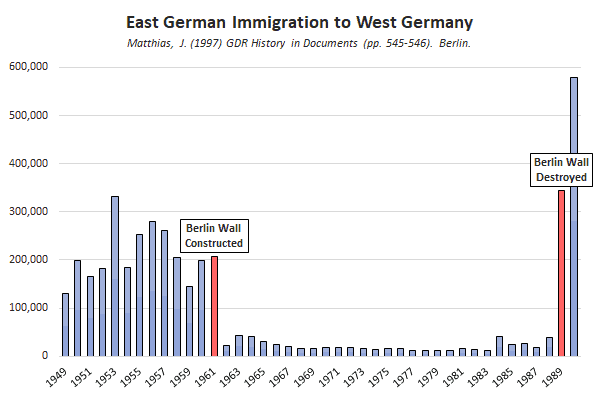
The wall was even more effective than this graph make it seem, because these figures include legal emigration. As the next graph shows, most of the movement to the West was legal. The wall and the “rampart” slashed defections to just 185 people per year.

Israel-Egypt Barrier
Israel takes border security very seriously. In January 2010, it decided to reinforce the fence on its border with Egypt to keep out terrorists and African immigrants.
The upgrade was finished in December 2013 at a cost of $470 million. The 16-foot-tall barrier ran 152-miles — the entire length of Israel’s southern border, from Rafah to Eilat — and included cameras, radar, and motion detectors.
While the fence slashed the number of “infiltrators,” the persistence of successful border incursions prompted Israel to raise the fence by 10 feet at certain undisclosed locations.

Israel’s upgraded 26-foot Sinai barrier, 2017.
The 2013 upgrade reduced illegal incursions at the border by an average of 99.4 percent. The improvements completed in January 2017 cut illegal immigration to zero. As of June 2017, not a single person had breached the fence.

Israeli West Bank Barrier
The 25-foot-tall barrier runs along the border between Israel and the Palestinian West Bank. For most of its length, it is a concrete wall, but in some places it is a fence. Construction began in 2002, in the midst of the Second Intifada, or armed Palestinian uprising. By 2012, 63 percent (277 miles) of the border was walled or fenced, but there has been little construction since then.
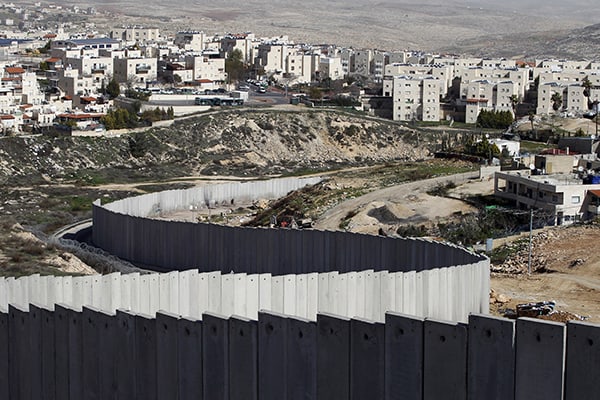
A section of the Israeli separation wall between the Shufat refugee camp and Pisgat Zeev.
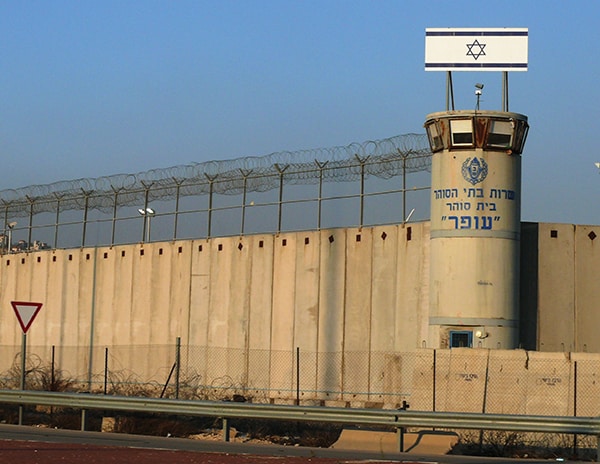
Israeli security towers along the West Bank wall.
Still, the barrier appears to have sharply reduced the number of Israelis killed by Palestinian terrorists by keeping them out of Israel. The following graph shows that the decline in the rate of Israeli deaths from terrorism closely tracks the construction of the barrier. Many factors affect the frequency of terror attacks, but making it harder for Palestinians to get into Israel is surely an important one.
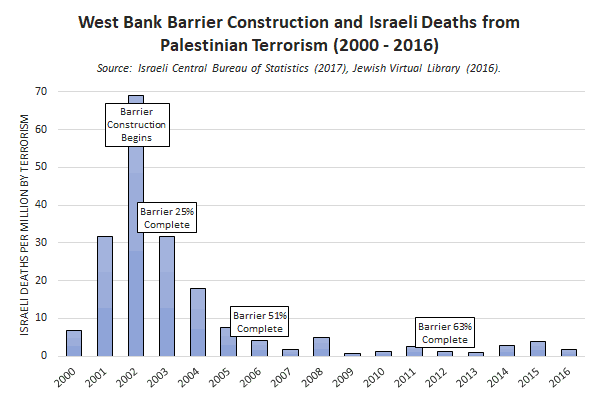
Hungarian Border Fence
In 2015, more than a million migrants poured into Europe from North Africa and the Middle East. That year, 410,000 crossed the Hungarian border. On a per capita basis, that would be like 14,000,000 illegal aliens entering the United States in a single year.
In July 2015, Hungary began building a 13-foot-tall fence along its borders with Serbia and Croatia. The 109-mile fence was completed on October 16, 2015 at a cost of roughly $106 million.

Building the barrier on the Hungarian-Serbian border (near Mórahalom).
The following graph is of daily apprehensions at the border during October 2015. Completing the fence cut the number of daily crossings essentially to zero.
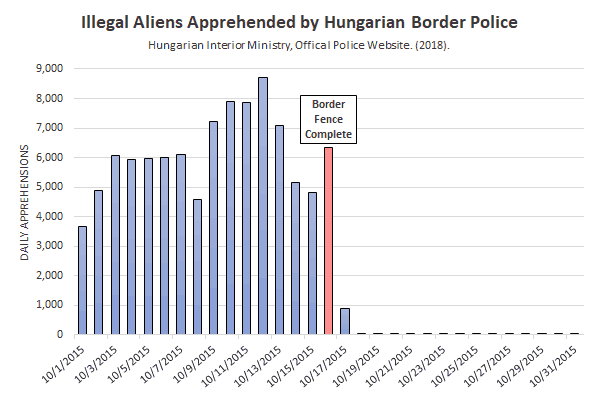
The fence has not been perfect. Following a general increase in migrant inflows to Europe, there was a slight increase in illegal crossings in 2016, which led to an average 130 apprehensions per day in June.
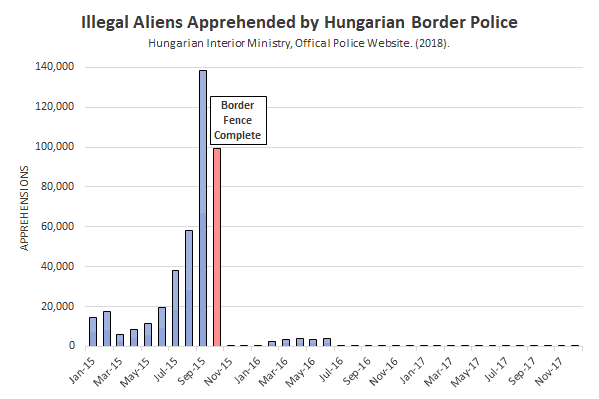
In July, Hungarian President Viktor Orbán sent 10,000 police and soldiers to the border. Since then, the number of illegal crossings leading to apprehension has ranged from 0 to 11 per day.
U.S. Border Fence – Southwest Border Sectors
The Secure Fence Act, passed by Congress in 2006, authorized the Department of Homeland Security to build 652 miles of fencing along the US-Mexico border. Ideally, a fence should cover the entire area it is meant to protect, but the law left large areas unguarded.
As the graph below shows, despite these shortcomings, the number of illegal aliens caught by US border patrol fell dramatically as the length of the southwest barrier increased — evidence that even a limited barrier can deter illegal immigration.
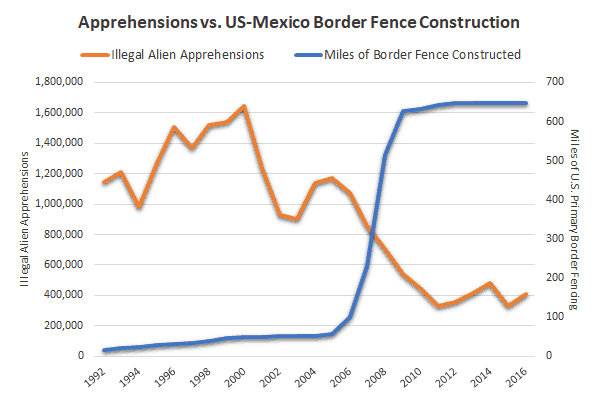
However, the picture is complicated. As shown in the graph below, the number of border patrol agents increased dramatically while the fence was being built, which makes it hard to separate the effect of the fence from that of increased patrols.
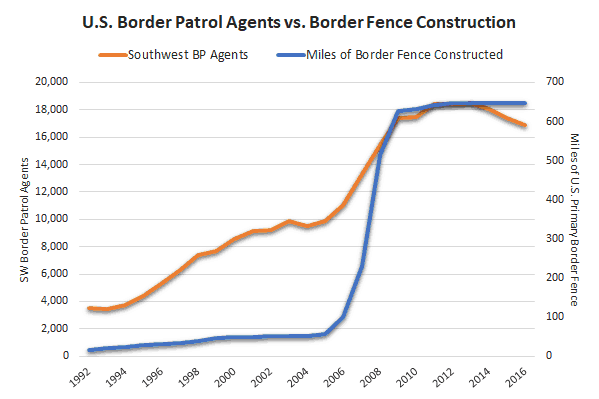
Moreover, many factors affect the number of people trying to cross illegally from Mexico: the American economy and demand for labor, Mexico’s economy and demand for labor, the effectiveness of Mexico’s own border control against immigrants from third countries, and the perception in Latin America and elsewhere of how diligently the United States is enforcing its immigration laws.
However, we can approach the effectiveness of the fence from a different perspective. The border with Mexico is 1,954 miles long and there are only 652 miles of fence. The fence has been built where the border was easiest to cross, but some illegal immigrants go around the fence to cross in more difficult areas. The Border Patrol is not catching all illegal immigrants. However, the presence of more agents at the border should mean that people who cross the border illegally are more likely to be caught — which increases figures for apprehensions.
If a border fence were not a deterrent at all, it would not reduce the number of border crossers. If, at the same time, patrols were increased, we would expect a rise in apprehensions, because more people would be caught. What actually happened between 2005 and 2016 was fence construction, more patrols, and fewer apprehensions. This is strong evidence that the fence sharply reduced the number of illegal crossings even while those who did cross were more likely to be caught. Completing the fence would presumably cut illegal crossings even further.
Widespread Use of Barriers
Border barriers are the international norm. Only 25 percent of the world’s population live in countries that do not have a border fence or wall — something far more substantial and lengthy than a fence at a border check point. Ten percent of the world’s population live on islands with no land borders. Fully 65 percent live behind barriers.

Nations with confirmed border barriers (shown in red).
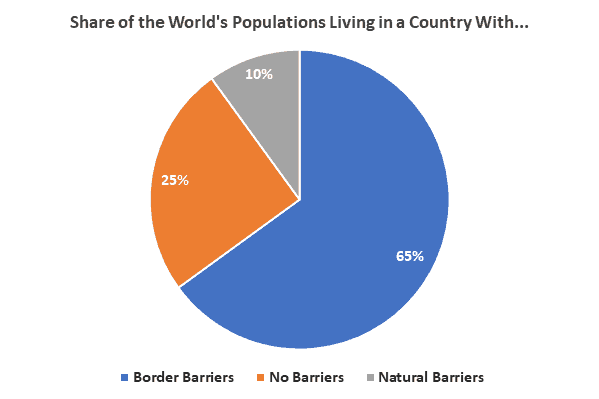
Only Western nations are condemned for building barriers, even though other regions are more likely to have them. As the graph below shows, East Asians, North Africans, South Asians, Middle Easterners, and Central Asians are all more likely than Europeans or the inhabitants of other majority-white countries to live behind barriers.

Only Latin Americans and sub-Saharan Africans are less likely to live in countries with barriers. Nations that are unattractive to illegal immigrants do not build walls.
Here are photographs of some of the border fences and walls found around the world.

A Pakistani soldier at the Afghan border.

An Iranian soldier guards a wall built where the borders of Iran, Afghanistan and Pakistan meet.
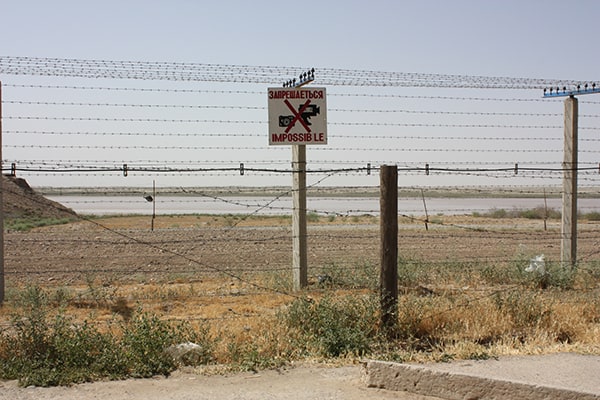
Uzbek fence at the Afghan border.
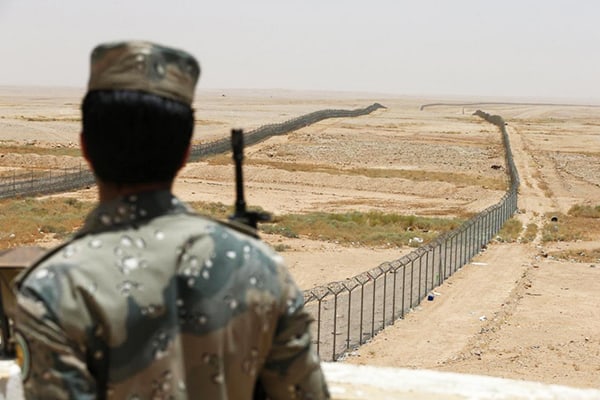
A Saudi guard at the Iraqi border.
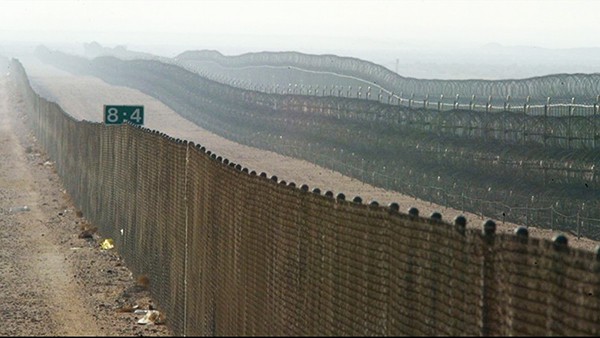
Kuwaiti fence at the Iraqi border.

Turkish guards patrol the barrier between Turkey and Iran.

Turkish soldiers on the Syrian border.
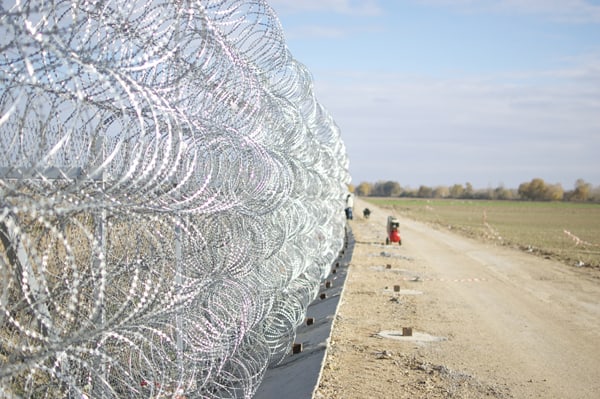
Greek fence completed in 2012 along the border with Turkey.
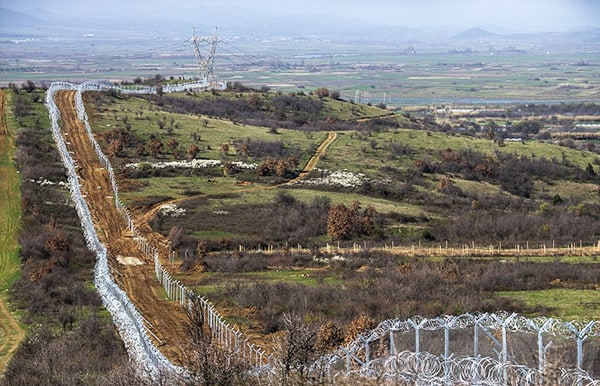
A Macedonian fence along the Greek border.

Indians patrol the Bangladesh border.

Myanmar police patrol the Bangladesh border.

Thai soldiers guard the border with Malaysia.

Ecuadorean workers build a wall along the border with Peru.

Argentina’s border with Paraguay.
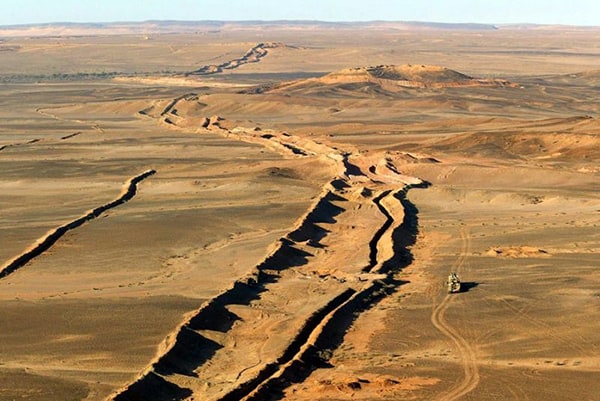
The Berm is a heavily mined 1,700-mile barrier separating Morocco from Western Sahara.

Kenya’s fence at the Somalian border.
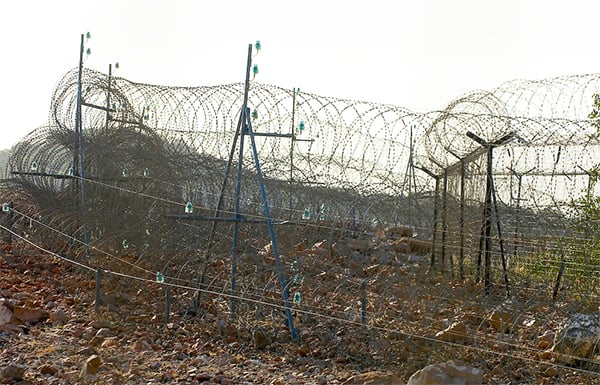
Fence along South Africa’s border with Zimbabwe.

Latvian guards at the Russian border.
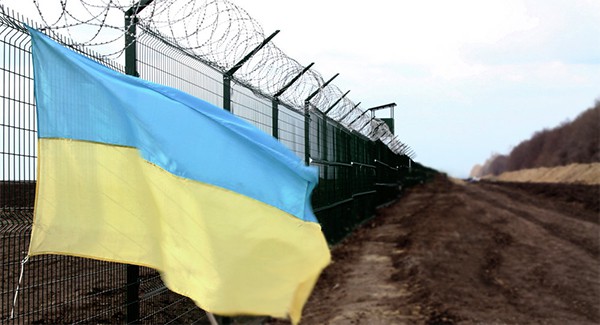
Ukraine’s border fence with Russia.

Bulgaria’s border with Turkey.















